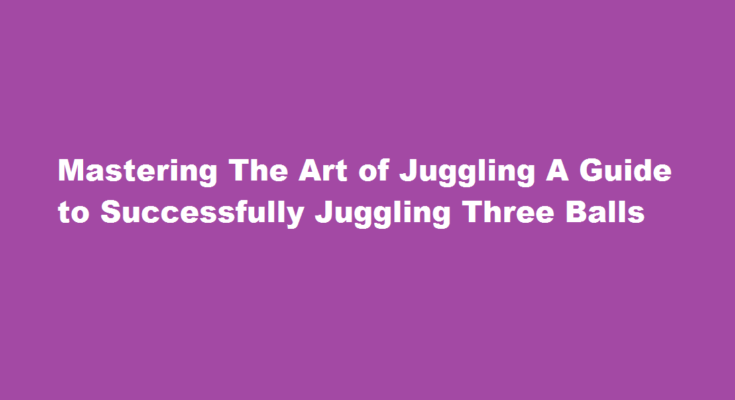Introduction
Juggling is a captivating skill that combines dexterity, coordination, and concentration. While it may seem daunting at first, with patience and practice, anyone can learn to juggle three balls. In this article, we will explore step-by-step instructions and useful tips to help you master the art of juggling. So, grab three balls and let’s get started on your juggling journey!
Choosing the Right Balls
Before diving into juggling, it’s important to select the right balls. Opt for lightweight, medium-sized balls that fit comfortably in your hand. Tennis balls or specially designed juggling balls are ideal choices. Avoid using heavy or hard objects, as they can be difficult to control and increase the risk of injury. Once you have your balls ready, find a spacious and clutter-free area to practice, preferably with a high ceiling to prevent any accidental collisions.
Establish Your Dominant Hand
Most people have a dominant hand that feels more comfortable and coordinated. Start by determining which hand is dominant for you. This hand will serve as the anchor while learning to juggle. Hold two balls in your dominant hand, while holding the third ball in your non-dominant hand.
Master the Basic Cascade
The basic cascade is the foundation of juggling three balls. Begin by throwing one ball from your dominant hand, slightly angled towards the opposite hand. As the first ball reaches its peak, release the second ball from your non-dominant hand in a similar manner. After throwing the second ball, quickly throw the first ball back to your dominant hand. Practice this back-and-forth motion until you feel comfortable. As you gain confidence, gradually increase the height of your throws.
Focus on Timing and Rhythm
Juggling requires precise timing and rhythm. Aim for a smooth and continuous flow of throws and catches. It’s crucial to catch each ball at the peak of its arc, allowing you enough time to throw the next ball. Initially, you may find it challenging to maintain this rhythm, but with practice, your brain and muscles will adapt. Counting out loud or using a metronome can help you establish a steady tempo and improve your timing.
Develop Peripheral Vision
Juggling requires excellent hand-eye coordination. To enhance your coordination, focus your gaze on the apex of each ball’s trajectory rather than staring at your hands. This technique allows you to use your peripheral vision to catch the balls accurately. Developing good peripheral vision takes time, so be patient and practice regularly. As you progress, try incorporating more complex patterns like under-the-arm throws and cross-body throws to further challenge your coordination skills.
Persist and Embrace Challenges
Juggling is a skill that demands persistence and perseverance. Don’t be discouraged by initial drops or frustrations. Embrace the learning process, and keep practicing. Start with shorter practice sessions to maintain focus and gradually increase the duration as you progress. Break down the juggling pattern into smaller components and work on each component individually before combining them. Remember, progress may seem slow initially, but with dedication, you will gradually develop the muscle memory and coordination needed to become a proficient juggler.
FREQUENTLY ASKED QUESTIONS
How long does it take to learn to juggle 3 balls?
Most people can begin to learn three-ball juggling in a few days. (Three balls is generally considered the entry point of actual juggling, which is broadly defined as the ability to manipulate more objects than one has the hands for.
Is juggling good for the brain?
Juggling boosts brain development. Research indicates that learning to juggle accelerates the growth of neural connections related to memory, focus, movement, and vision. The beneficial changes persist even after weeks without practice.
What is the hardest juggling trick?
Along with Mills Mess and Burke’s barrage it is one of three well known named juggling patterns that involve complex carries and crossed arm throws. Rubenstein’s revenge is usually considered the most involved and difficult of the three.
Conclusion
Juggling three balls is a captivating and rewarding skill that anyone can learn with practice. By following the steps outlined in this article, choosing the right balls, focusing on timing and rhythm, and embracing challenges, you can gradually master the art of juggling. Remember, the key is consistent practice and patience. So, grab those balls and embark on your juggling journey. With determination and perseverance, you’ll soon be delighting audiences with your impressive juggling skills!
Read Also : Mastering The Versant Test Strategies for Success



